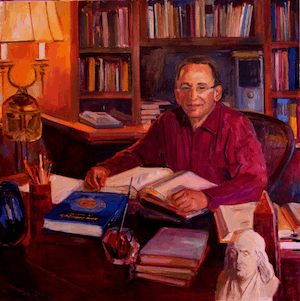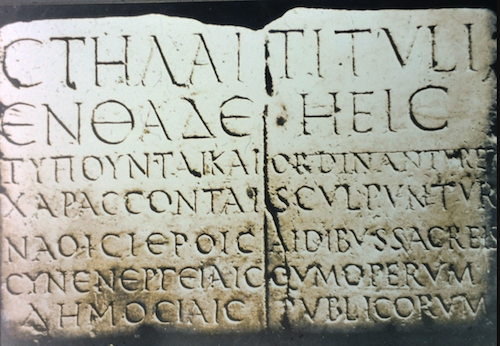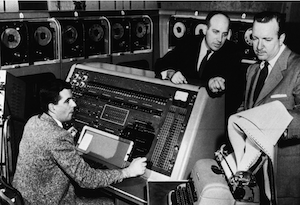 |
|
Jeremy Norman in 2008. Oil painting by Kathleen Lack. The painting emphasizes my connection to physical media, though the telephone and computer are visible in the background. The sculpture in the foreground is of the printer, writer and politican Benjamin Franklin.
|
From time to time we may feel awash in a sea of random information and media, sometimes characterized as "information overload"—feelings that have been exacerbated by the Internet. Thanks to search engines we may find answers of varying quality to the most esoteric or routine questions in two seconds, but what tends to be much more complicated is evaluating search results, or placing search results in perspective, especially if we want to understand a topic from an historical point of view. The many extensively annotated timelines available in HistoryofInformation.com are designed to help you follow the historical development of physical and digital information and media, and attitudes about them, and interrelationships between them, in both theory and practice, from the beginning of records to the present. Containing annotated references to discoveries, developments of a social, scientific, or technological nature, as well as references to physical books, documents, artifacts, art works, and to websites and other digital media, HistoryofInformation.com arranges both chronologically and thematically, selected historical examples and developments in the methods used to record, distribute, exchange, organize, store, and search information. The timeline database focuses on the development of selected examples of media, and to the extent practical, comments on, summarizes, and links to further information regarding their content.
 |
| A representation that may be viewed as seeking insight through digital information. Image from resonancescience.org. |
Consisting of more than 5,000 illustrated entries covering a diverse range of the history of physical and digital information and media, the timeline database allows you to approach the topics pretty much any way you choose. My intention in building this database has been to collect and organize an exceptionally diverse collection of facts, stories and data in flexible ways that I hope make the development of various topics in the history of information easier to follow and understand. The result of twenty years of collecting and writing, the data covering thousands of years and locations around the world is exceptionally diverse, and may initially appear overwhelming. But if you enjoy detail like I do, and you want to immerse yourself in elements of the history of information, this site presents unusual opportunities.
You can approach the data through one of the more than 100 themes that I have charted. You can mix or match themes to create any kind of timeline search you want, within any time frame you want, and if you use more than one window in your browser you may compare more than one timeline theme at the same time. You may search any word or combination of words in the database using the keyword search. Because the keyword search presents results chronologically, through the keyword search you may create a timeline on virtually any word or phrase in the database. You may access the data geographically and thematically using the Maps program. The Outline version of the database shows only the headlines of entries and a single illustration. If you click on the Outline version of an entry you will find more documentation and more images below. I tend to be as interested in the means of production as in the finished product, so you will find the technical mixed with the aesthetic.
Background
For many years I have been accustomed to organizing information chronologically and thematically. Whenever I witness a new development I find myself searching for its precursors, and when I study historical developments I try to view them within the context of prior and later events. In 1991 I issued the fifth edition of Morton's Medical Bibliography, a collection of annotated chronological lists of the primary and secondary historical literature of medicine and biology. This printed book of 1243 pages contained 8927 entries. When I prepared the new edition during the late 1980s I wrote the manuscript in a word processing program on a laptop computer, but did all of my research from books and printed periodicals, either in my own library or at institutions. Among the limitations of the work in codex form were the rigid way it had to be organized, space limitations of the physical volume, and the indexes, which occupied the final 200 pages. These limitations I remedied in the greatly expanded interactive online version of the bibliography at historyofmedicineandbiology.com.
The roots of the present project are in a relatively brief static timeline on the history of computing, networking and telecommunications that I published in my 2002 printed book Origins of Cyberspace. In my 2005 printed book, From Gutenberg to the Internet, I expanded the 2002 timeline somewhat, and began to consider the relationship between developments in media in our time and what is typically described by historians as the media revolution associated with Gutenberg's invention of printing by movable type in the 15th century. Dissatisfied with the superficiality of that effort, and searching in the midst of the information overload that many of us experience for a way to put rapidly evolving modern developments in perspective, but unaware of any model for my research, I continued expanding the timeline on websites, gradually adding new features as programming opportunities became available. Since 2017 web developer Vann Miller has improved and upgraded every aspect of this website, as well as my other websites, HistoryofMedicineandBiology.com and HistoryofScience.com.
Chronological, Thematic, and Geographic Researches, and their Limitations
From its beginnings in print HistoryofInformation.com evolved into this dynamic and interactive form far different from the codex. Because of its historical approach, numerous precursors to aspects of HistoryofInformation.com may be found within this database itself, particularly through the Indexing & Searching Information, Knowledge Organization, and Timelines & Chronicles themes. You will find links to themes at the end of each entry. If you click on a theme after an entry you will see a timeline based on that theme alone. In order to follow the development of concepts or technologies from their origins, and to offer thought-provoking associations, I define themes loosely. To make some themes more accessible to historical treatment I sometimes combine related themes. For example, I combined Internet & Networking in order to trace this theme back to the first road networks in the ancient world, to railroads, to the telegraph lines that followed railroad lines, to telephone networks, up the network of networks that is the Internet. I also combined Social Media, Social Networks & Wikis to show a longer history for both topics. If you find some of my thematic associations controversial or thought-provoking that is my intention.
This project, like so many other web projects, is effectively a collaboration between myself and many authors online and in print. The project is based on my growing personal library of physical books on the history of information, access to digital books and journal articles, and the work of countless contributors to websites. I also benefit from online discussions on the Exlibris electronic discussion list of the Rare Book and Manuscript Section (RBMS) of the Association of College Research Libraries (ACRL). Typically I use books as tools, rarely reading a complete work, so that I sometimes think of this project as a kind of publically usable and searchable commonplace book.
To the innumerable contributors to the Wikipedia I am especially grateful. Throughout the database users will find many quotations from, and links to, the Wikipedia. After the Wikipedia the source I cite most frequently is The New York Times. I provide dates of access for sites from which I have taken quotations to provide a means of finding the information in the Wayback Machine of the Internet Archive if the site from which the quotation was taken closes or changes. From the standpoint of selecting sources for links, the Wikipedia and The New York Times have the advantage of presumed longevity. This was confirmed many times over when I reviewed all of the entries in this database between 2019 and 2020, especially during in home isolation as a result of the COVID-19 pandemic. In the course of that review I found that, with the exception of digital libraries and other sites that maintain persistent identifiers, links to many sites other than the Wikipedia and The New York Times, were no longer operational. During that review I selected the Athenian tetradrachm coin as a logo for the website. The classical Greek depiction of Athena's owl on the tetradrachm symbolizes the goals of HistoryofInformation.com to organize and present historical data in order to gain insight from study of the past.
While I am careful to cite my sources accurately, in order to build a database of this scope I work under the assumption that not all of the information or references can be verified. Paraphrasing a statement made by the Renaissance scholar-printer Aldus Manutius in his preface to his edition of Theocritus (1495/96 ), I believe that publishing ”something is better than nothing," and that my primary task is to set down the information in useful form, to be improved later, if possible. I also believe that a published text may find many correctors, with the difference that the Internet compounds the problem by the speed at which it spreads true or false information. Whenever I find inaccuracies in HistoryofInformation.com I correct them. Please report errors that you find.
Why Did I Undertake This Project?
Anyone who reviews this database in detail, and appreciates its scope, might very well wonder why I undertook this project which is, of course, impossible to complete. Not only is the scope of this project beyond the reach of an individual if comprehensiveness is expected, but the very notion of completeness may be inapplicable. As has often been said, we are presently experiencing one of the most significant and dramatic transitional phases in the evolution of information and media. The transition from a world in which information was primarily recorded, distributed and stored in physical form on paper to a world in which most information is recorded, distributed and stored in digital form, has occurred mostly within my lifetime. I was born in 1945, just after World War II ended, and soon after the first general purpose electronic digital computer, the ENIAC, became operational. I distinctly remember the first time I heard about an electronic computer in November, 1952, watching Walter Cronkite on television showing the UNIVAC predicting the election of President Eisenhower. I was then seven years old. The ongoing dramatic changes in media, which all of us have experienced since the arrival of the personal computer, the Internet, and the cloud, have caused many of us to wonder how all these changes came about. More specifically, as I write in the essay entitled Are we living through a media revolution like the one that occurred in the mid-15th century?, I was originally motivated to answer that particular question. Twenty years later I think the answer to that very general question is less significant than documenting aspects of the highly complex and multi-faceted developments that lead to the present.
Collecting Virtually and Physically
Yet why have I doggedly pursued this project for the past twenty years? Until recently I had trouble explaining my motivations in a satisfactory way, but after twenty years I think the answer is clear. To a major extent I have collected my way through life, both in the physical and virtual sense, and this project represents one of the ultimate challenges in collecting. When I was young I collected what I called my Darwin's Century library on the history of evolution and biology. Later I began the virtual collection of what is now the online bibliography of more than 15,000 items at www.historyofmedicineandbiology.com. In between I collected a pioneering library on the history of computing, networking and telecommunications recorded in Origins of Cyberspace. As an antiquarian bookseller for over fifty years I have bought and sold tens of thousands of rare books and manuscripts. As an individual, outside of the book business, I am presently donating individual items and collections to institutions. Because I have always learned best through writing, as I collect it has been my policy to write about what I collect either in the sense of writing booksellers' catalogue descriptions or publishing books or websites about my private collections. HistoryofInformation has been a collecting challenge of the most complex kind. It has been a process of collecting and writing about virtual information concerning the widest range of things and ideas, and also collecting and writing about the physical objects in my growing library of primary and secondary sources on available and affordable aspects of this project. As I have collected I have been writing, illustrating, and revising the database, and as the virtual and physical collection has grown so has the website, both in size and nuance, reflecting what I could collect and understand, and what can be effectively displayed online. After pursuing this project for twenty years I remain fully committed to following this open-ended quest. It is my pleasure to share this growing interactive record of my ongoing voyage through the history of information and media. Your comments are welcome. Bon voyage!
Jeremy M. Norman
January 2, 2021





